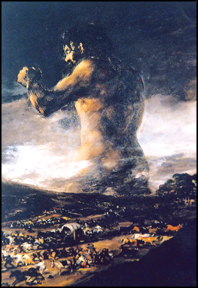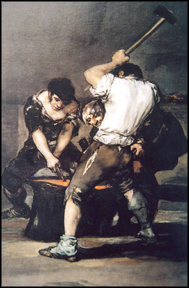Why the great Goya never appealed to me
by Gwen HERAT
Goya reminds me of yet another melancholy painter whose art is full
of macabre disillusions. Nothing awesome: nothing glorious: nothing
pleasant: The painter I am referring to is Joze Tisnikar, a Belgrade
pathologist/painter known as 'The Painter of Death', a very modern
artist who may have been inspired by the great, great Goya.
|

The Colossus
The painting that set Goya apart from the rest of the masters;
great and magnificent. |
Goya is the artist who 'kills' most of his subjects, animals such as
horses and bulls in their rings. He loves torturing them in his art. A
near-paycho or an artist who only saw the devastating side of life,
mostly in dumb creatures.
But Goya had his good side... the spirit of man. But this too has
turned into catastrophe, often shying away from reality. He was a
detailed artist where nothing escaped his eye.
Was he complexed or a genius?
There are two schools of thought on this. Goya lovers swear by his
artistic superiority and people like me who find him a gory artist.
There may have been a reason hidden at the back of his mind. As a child
he would have been traumatised at the sight of blood in Spain's bull
rings? Living through the French Revolution when European society
challenged the power of kings and Spain being old-fashioned, resisted
the changes and Goya being a patriotic Spaniard, witnessed the bloody
war against the foreign invaders in his beloved country and recorded
those turbulent horrifying events in powerful ways. He had seen too much
blood and it may have been this infirmity that put his nature on his
art. Goya's images are brutally realistic because he painted them in
their authenticity. Goya was a man of his time which was called the Age
of Reason. He may have been trapped by the light of reason as well as
the dark monsters that hid inside the mind of man. He bears witness to
this in one of his last masterpieces which is 'Self-portrait with Doctor
Arrieta' where he is almost dying but is nursed back by his loyal
doctor. Some have speculated that the shadowy figures in the background
of this painting are friendly servants. Others suggest that they are
demons of death waiting for Goya's soul. He fabricated this highly
personal double portrait from a grateful memory.
In every self-portrait of himself, Goya made himself look sinister or
horrifying. All art lovers who have seen the magnificent painting of
'The Family of Charles IV' will agree that his genius in placing the
Spanish Royalty on canvas so that the generations that followed, will
marvel at it. Thirteen members of the Royal Family, regally attired,
reveal the flamboyance of the era. These are the two sides to his art.
One by one, as our art teacher introduced the Masters to our class, I
was horrified when it was Goya's turn. The horrible, cannibal like giant
in a painting called 'The Colossus', hit me where it hurts most. I still
remember how it mentally affected my spirit when I was hardly a
14-year-old girl.
I tossed in bed that night imagining this horrible creature would
appear from the dark. 'The Colossus' appeared a ravenous demon to me but
decades later I was to learn that this painting is Spain's pride and is
one of the most treasured classics, unparalleled in the history of art.
Though I was shattered by this painting, I discovered the brighter side
of his art. I found a sense of intellectuality and inborn genius
nurtured by what he saw in man. His favourite colour was black.
|

The Forge
Goya celebrates man-power and dignity of labour in Spain. |
He paid very little attention to the background of his paintings,
roughly indicating their presence. The focal objects were filled with
loose brush strokes. Though Goya specialised in painting women, he
clothed them with modesty. Mostly dressed in traditional Spanish
costumes, he sealed their identity. However, Goya's favourite subjects
were scenes from everyday Spanish life. He was passionately fond of his
country and surfaced her majesty whoever possible.
Goya was inspired by none other than his own, the great Spanish
painter of the previous century, Diego Velazquez. Being so carried away
by his Master's style and natural way of painting, he followed the finer
points. He found his idol's realism unsurpassed even during his time.
Francisco Goya (1746-1828) was born in the village of Fuendetodos. It
was a desolate region in the north of Spain. His father was a gilder who
also managed his small farm that sustained the Goya family. He attended
a religious school where he was a restless, turbulent pupil. Later, he
went to Madrid where Goya's growing talent was soon observed by another
artist, Francisco Bayeu who taught at the Royal Academy of San Fernando.
Bayeu who was also the court painter to the King of Spain, chose Goya to
be his assistant.
Thus began his fantastic career that zoomed with every move he made.
After Goya returned, Bayeu commissioned him to decorate the ceiling in
Saragossa's cathedral. As Goya experienced and blossomed out to be an
icon artist, Bayeu never ceased to help him. In 1773, Goya married
Bayou's sister Josefa and became an independent artist. He later became
the court painter. In the meantime, Goya had done several masterpieces,
one not better than the other. He had no rules in painting and never
belonged to any school of style.
Sometimes, he would paint for ten hours non-stop. For him light had a
symbolic meaning and he adjusted to balance his palette in a way to trap
the light be it night or day. Goya broke the basic rules to emerge the
Master of it. Painting light without a brush which is the conventional
method of applying paint, he scaped the paint with knife and even
applied it with his fingers for better effect.
A much celebrated painting depicting the dignity of labour, Goya
painted the 'Forge' from a point of departure from an earlier painting
called the 'Gravediggers' where he used only brown and grey. He
celebrates the power of man and reveal the forging of piece of metal by
blacksmiths. Their torsos are tightly grouped to reveal the intensity
from a vantage point. It has been painted from below eye level, inviting
the viewer to look up for greater impact.
Three Spanish nationals in compact position whom Goya has painted
with broad brush strokes are in greater focus because he has eliminated
the usual tools and supplies found in a blacksmith's shop. By applying a
simple grey frame around the figures, it is a celebration of manhood.
The canvas upon which he painted is six feet tall.
As though to terrify humanity, a giant rises over the horizon,
clothed only in billowing clouds.
It gives the impression that the end of the world is round the
corner. An enormous giant treads the countryside. Goya has used a
dramatic contract of colour to make the figure eerie and scaring.
He may have even intended painting the giant's birth as he emerges
from the earth. Although the 'Colossus' is walking away from the valley,
he frightens the people, cattle, horses and the caravan when they are
ready to leave on their usual weekly visit elsewhere. Instead, they run
amock with frenzy, bulls stampeding in the opposite direction.
A man falls off his horse and women collapse, screaming children
cause chaos and panic. Goya describes in detail the frantic attempts to
escape while the cool, collected giant slowly walks away; Goya stamped
his signature and authority and spectacular brilliance on this priceless
masterpiece.
|

